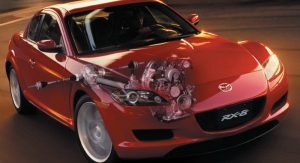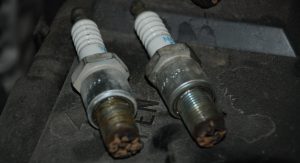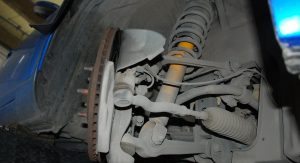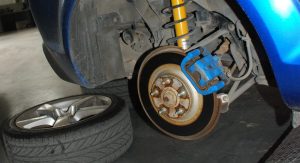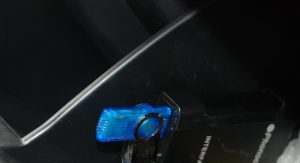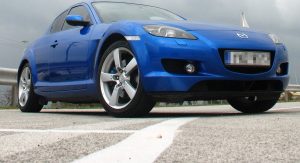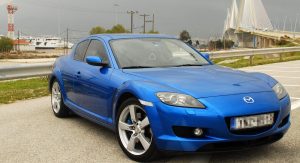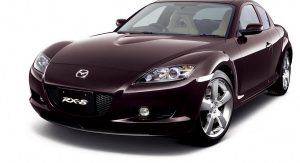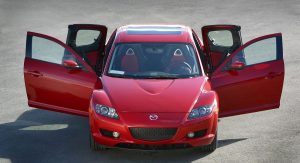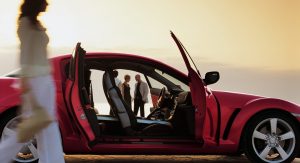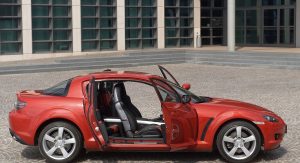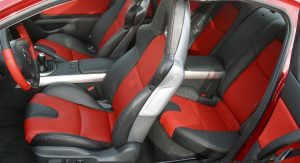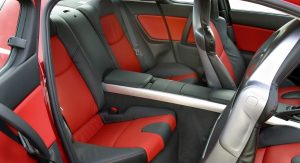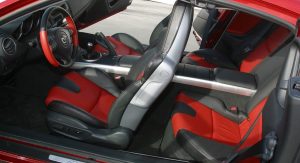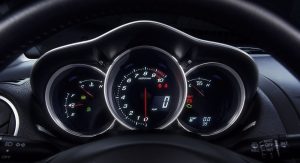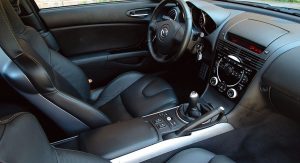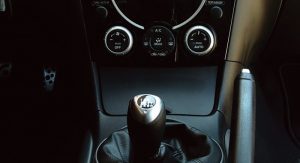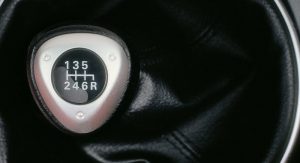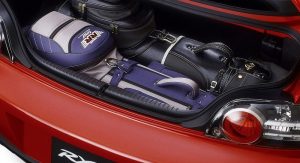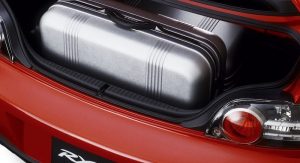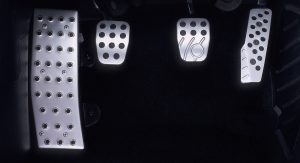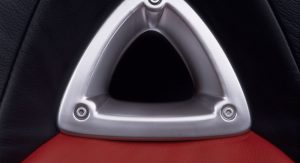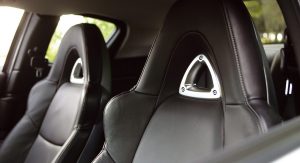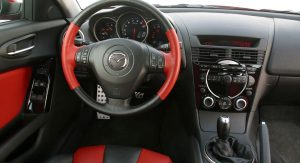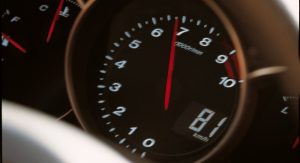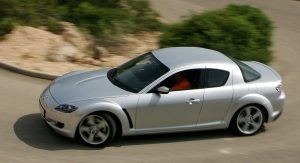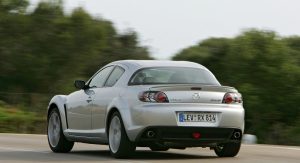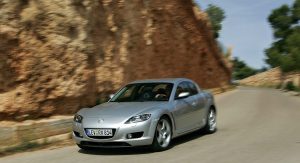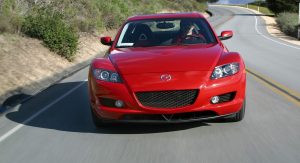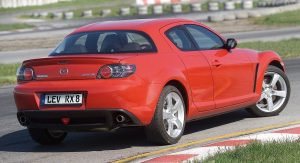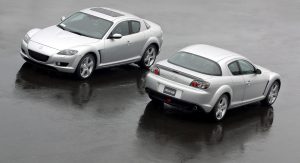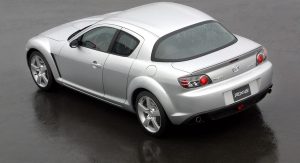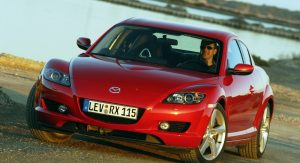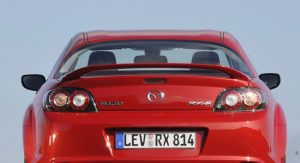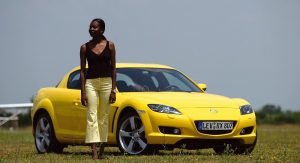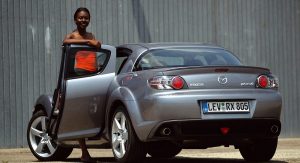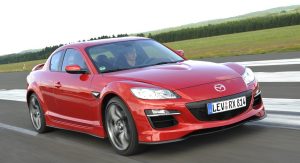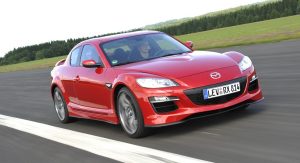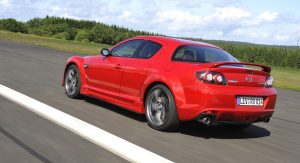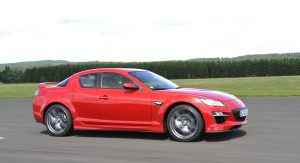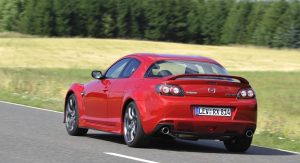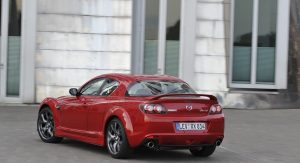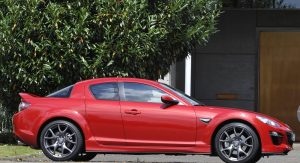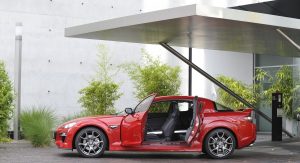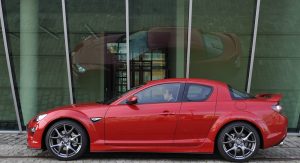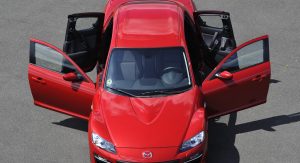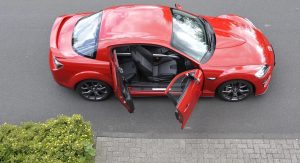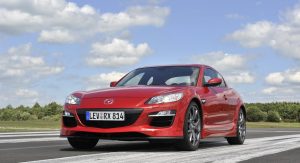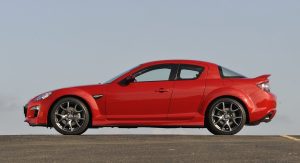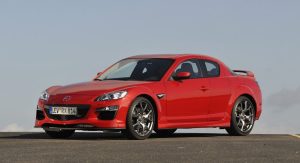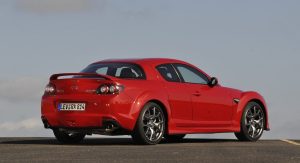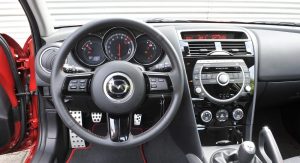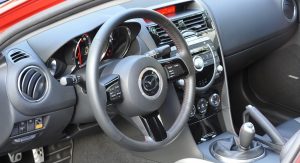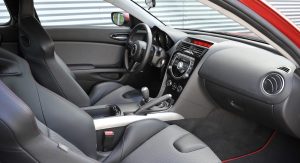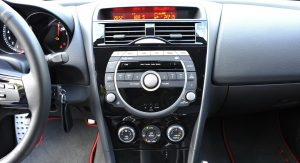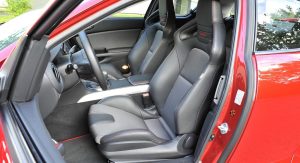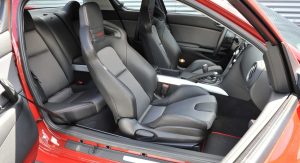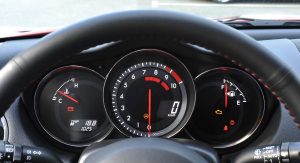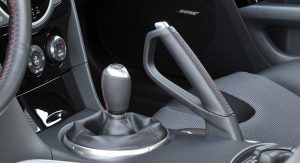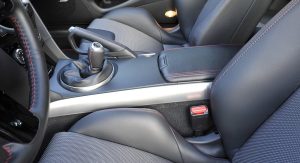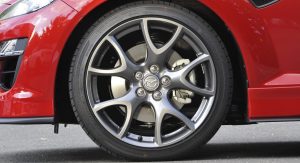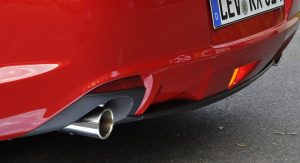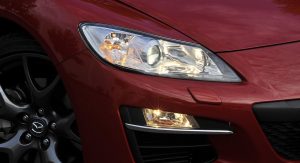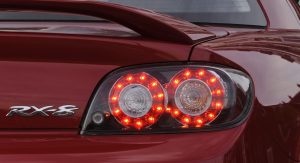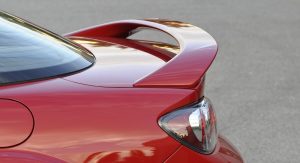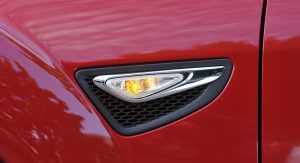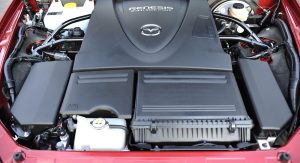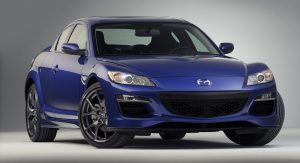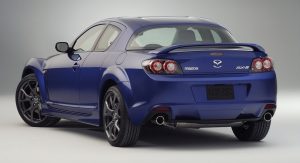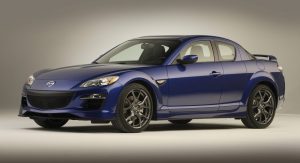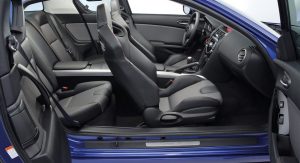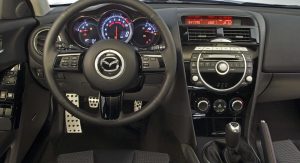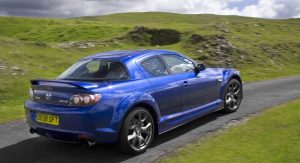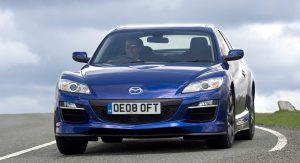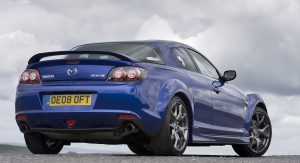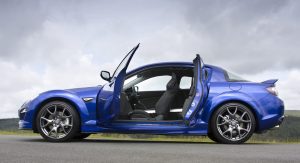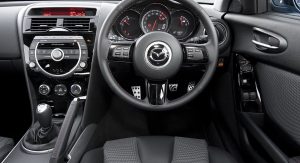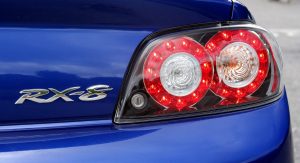“The RX-8 doesn’t just like a drink; it is the founding member of the AA institution for sports car engines”
Are you tired of my RX-8 reports yet? If you secretly nodded your head in agreement, then I have good news for you, because this will be the final one, in which I’ll try to recount the ups and downs of running Mazda’s last rotary sports car – until, hopefully, the next one comes up…
First of all, let me introduce you to the world’s first contemporary four-door coupe. The Mercedes-Benz CLS that supposedly invented the niche? It was launched a year later than the RX-8, which is a coupe and has four doors. True, the Merc and its clones are perched much higher in terms of pricing and none adopted the rear suicide doors that did without the B-pillar, but you get the point.
There’s nothing else like it on the market – period. Its powerplant shuns valves, pistons and conrods for ports and rotors and thus produces 228HP from a capacity of just 1.3 liters and a mad 9,500 rpm redline. I’ll admit, it suffers from a severe lack of low-end torque, but it revs so creamily and effortlessly that a chime has to remind you to change up before you hit the limiter.
 This comes at a price. The RX-8 doesn’t just like a drink; it is the founding member of the AA institution for sports car engines. Yes, it really is that bad. No matter how gentle the right pedal is treated, a shocking 16-18 lt/km (15-13 mpg US) average in mixed use is common. Combine it with the 61–liter fuel tank and visits to gas stations are much more frequent than Lindsay Lohan’s to courts and rehab facilities.
This comes at a price. The RX-8 doesn’t just like a drink; it is the founding member of the AA institution for sports car engines. Yes, it really is that bad. No matter how gentle the right pedal is treated, a shocking 16-18 lt/km (15-13 mpg US) average in mixed use is common. Combine it with the 61–liter fuel tank and visits to gas stations are much more frequent than Lindsay Lohan’s to courts and rehab facilities.
On the bright side, it doesn’t get that much worse when it gets a good pasting. Thus, since the tank and wallet are draining at nearly the same rate regardless of speed, better to indulge in it. That’s what it was made for after all, right?
Well, it is made to drink oil as well. Not synthetic, as when it burns it leaves a residue that, in time, doesn’t do the engine’s seals any good and (fingers definitely crossed), so far, not lots of it. However, you do have to monitor it constantly. Mazda says every second fill up, I do it every 450-500 km (300 miles) at the most to be on the safe side. A liter of oil plus a funnel as the oil cap is placed way back in the engine bay are always in the trunk.
By the way, the latter’s too small and its opening is too tall and narrow in the name of chassis rigidity. I’ve yet to see an RX-8 with a trailer or a roof rack so probably everyone must pack lightly or simply doesn’t undertake long journeys in it.
That’s a shame because as you’ve probably read and yours truly can honestly testify the RX-8 is a hoot to drive. The steering is accurate, full of feedback and sharp without being twitchy. In spite of being electrically assisted, it’s neither light nor artificially heavy at high speeds either, just nicely textured, passing through the information about what the front wheels are doing in real time.
The suspension strikes the right balance between tight body control and suppleness. You won’t mistake it for a Jaguar but it’s considerably better than you expect, especially when you factor in the low-profile tires, with both primary and secondary ride being very good.
Mind you, it rolls into corners a bit too much, at least for my liking. At first you believe that you’re really pushed it to its limits only to try again and find out that there’s much more grip available than you’ve been led to believe by the car’s initial behavior.
 After some research, I found that in 2006, Mazda rolled out (pun intended) the PZ, a UK-only limited edition developed by Prodrive that featured 60 percent stiffer Eibach springs and Bilstein dampers. Motoring magazines that road-tested the PZ reported that it was sportier without sacrificing ride quality and, indeed, I’m considering fitting those Eibach springs if and when finances allow it.
After some research, I found that in 2006, Mazda rolled out (pun intended) the PZ, a UK-only limited edition developed by Prodrive that featured 60 percent stiffer Eibach springs and Bilstein dampers. Motoring magazines that road-tested the PZ reported that it was sportier without sacrificing ride quality and, indeed, I’m considering fitting those Eibach springs if and when finances allow it.
Other gripes? Soft plastics are noticeable by their total absence in the, otherwise ergonomically sound cabin. In addition, the stability control system betrays its age by intervening too harshly and not having a “sport” mode.
Of course, you can just switch off the traction control or put the electronic nanny to sleep altogether. You can drive briskly and still have lots of fun, but when you edge close to the limit, you’d better have your wits about you as the limit of adhesion is high so, when you breach it, things happen fast.
I call them as I see them and certainly, I won’t be surprised if the above has put you off buying an RX-8. It might be cheap to buy but fuel expenses, constantly checking the oil level and all the stories about failing engines that are circulating, many of which are true, are enough to make you steer well clear.
You’ll be missing out on a great sports car, though. While it’s not as visceral, fast or sexy-looking as its predecessor, the twin-turbocharged RX-7 FD, it still looks the part and it’s infinitely more practical and easier to drive.
It also has the same uncanny ability to make its driver feel one with the car as it’s got all the basics right, from the driving position to the steering, quick and slick gearbox, strong brakes that are full of feel, instant throttle response and the chassis which is reassuringly stable yet eager to play when you are in the mood.
The RX-8 belongs to that rare breed of cars that feel alive by constantly feeding you information through the helm and the chassis. In spite of the technology it packs, it delivers an analogue driving experience. True, there’s no funky infotainment system, electronically adjustable damper, steering or throttle mapping, fake noise generators, not even a trip computer, though I have a feeling that the last one is an intentional omission so that you don’t faint at the fuel consumption display…
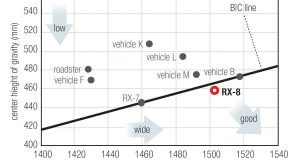 It’s no coincidence that Toyota considered a Wankel engine for the GT 86 / Scion FR-S along with the flat-four, which was its final choice. The reason is that it’s so compact it can be placed very low and back in the engine bay, enhancing the car’s driving dynamics.
It’s no coincidence that Toyota considered a Wankel engine for the GT 86 / Scion FR-S along with the flat-four, which was its final choice. The reason is that it’s so compact it can be placed very low and back in the engine bay, enhancing the car’s driving dynamics.
That 460 mm center of gravity it has been boasting about? Guess what: the RX-8 got there first nearly a decade ago, plus it’s got a carbon fiber propshaft. How about that?
Still interested in an RX-8? Then read on
– Early cars are nearing their 10th birthday and most cheap examples out there are at least five years old. A stamped service book is a must but simply not enough: insist on seeing invoices, too, and check that all services have been performed in a timely fashion. If you have doubts or the seller baulks at any point, walk away and run as fast as you can. Mazda has sold many samples so there are many more fish in the pond. Paying a bit more for a nice, well cared for example is preferable to saving up front only to be faced with a (very) expensive repair down the road.
 – Perform a compression test. It takes less than an hour and can be done by any official dealer or specialist. This involves taking out the “secondary” spark plugs and inserting the measuring instrument’s cables, then cranking the engine. The minimum reading should be 680 kPa at 250 rpm. Compression will deteriorate with mileage, but if the reading is near or just under that threshold, it doesn’t necessarily mean the motor’s doomed but a few ponies will be missing, something you may or may not even notice.
– Perform a compression test. It takes less than an hour and can be done by any official dealer or specialist. This involves taking out the “secondary” spark plugs and inserting the measuring instrument’s cables, then cranking the engine. The minimum reading should be 680 kPa at 250 rpm. Compression will deteriorate with mileage, but if the reading is near or just under that threshold, it doesn’t necessarily mean the motor’s doomed but a few ponies will be missing, something you may or may not even notice.
– Check that the engine starts properly when warmed up. If it doesn’t, it can be due to one of four things: low compression, faulty coils, worn spark plugs or a weak starter motor. The first two are the most expensive to fix. The starter motor on early models was too weak and Mazda later switched to a faster-spinning unit, which is the one to get if the original gives up the ghost.
– Letting the engine warm up and giving the fluids some time to circulate before you drive off is advisable and will prolong its life. It’s not hocus-pocus: Mazda fitted the rev counter with a “moving” red line indicator in the 2008 revamped model, much like BMW in its M cars, that gradually increases the rev limit as the engine warms up.
– Switching the ignition off before the engine is fully warmed up is a no-no or you risk flooding it and then it won’t restart no matter what. Flooding is something you don’t want to happen to you. It doesn’t kill the engine per se, but the car must be towed to the workshop where parts will be taken out, spark plugs most likely replaced, a special procedure will be performed to de-flood it and a nice invoice will be handed to you…
– Short-shifting is okay but once in a while, you need to rev it to around 7,000 rpm. That’s because the High Power motor’s third fuel port doesn’t open until 6,250 rpm. Thus, if you don’t explore the upper echelons of the rev counter and constantly stay at, say, around 4-5k, it may become clogged after time.
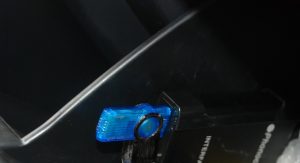 – High-spec versions came with a nine-speaker Bose audio system built in the dash. This also featured a six-disc CD-changer that a.) does not play MP3s and b.) a number of units has been known to fail at some point. To no one’s surprise, mine promptly did a few weeks after buying the car. Replacement units don’t come cheap while a web search revealed that used ones are not exactly bargains and there’s no guarantee they won’t fail, too.
– High-spec versions came with a nine-speaker Bose audio system built in the dash. This also featured a six-disc CD-changer that a.) does not play MP3s and b.) a number of units has been known to fail at some point. To no one’s surprise, mine promptly did a few weeks after buying the car. Replacement units don’t come cheap while a web search revealed that used ones are not exactly bargains and there’s no guarantee they won’t fail, too.
If, like me, you won’t settle for just the radio, a nice and pretty affordable solution is a little device with USB, SD card and iPod connectivity that makes the system’s software think it’s the CD-changer. All I had to do was make six folders in my USB, name them CD 1-6 and drop in my favorite songs, up to 99 in each folder. Yeah, having to make do with just 594 songs can be a drag but still, better than nothing…
 – The tail lamps are prone to letting moisture in (yep, mine did have one of those, too – the right one). If you can spare the time, it’s a DIY kind of job. Just remove about a dozen screws or so, air blow it until it’s dry and then put it back together, preferably with silicone around its edges so it will be sealed. Just make sure you remember which screw goes where J
– The tail lamps are prone to letting moisture in (yep, mine did have one of those, too – the right one). If you can spare the time, it’s a DIY kind of job. Just remove about a dozen screws or so, air blow it until it’s dry and then put it back together, preferably with silicone around its edges so it will be sealed. Just make sure you remember which screw goes where J
– Rear three-quarters visibility is horrid due to the fat C-pillar that seriously obstructs your view. Extra care is required when reverse parking (the alloys are easy to scratch, as I’ve found out…) and in angled junctions: I once nearly missed a full-size SUV!
– In the wet, in poorly maintained roads and at a brisk pace the tail is prone to slide first, ask questions later. I first blamed the tires but after a more thorough examination and a bit of experimenting, I put it down to the Torsen rear diff that, by nature, relies on at least one of the wheels having sufficient traction to work its magic. I suspect a mechanical diff would be better but anyway, after a few abrupt slides in pretty bad conditions, albeit not exactly at cruising speeds, I’ve learned to pay more attention, slow down or, alternatively, don’t push the bloody DSC button.
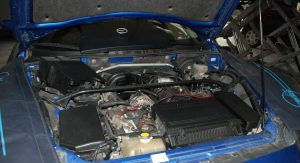 – The RX-8’s 228HP won’t win you any drag races, especially if you’re caught in the wrong gear. This can be rectified by tuning, the most common form being turbocharging. A bolt-on kit by a reputable tuner, complete with intercooler and all the necessary parts, promises around 300 horses at the wheels. Having sampled such a car the claimed number seemed pretty believable and low-end torque was certainly not an issue anymore. On the other hand upping the power puts more stress on an already stressed engine. As for the fuel consumption, if you have to ask, then you certainly can’t afford it…
– The RX-8’s 228HP won’t win you any drag races, especially if you’re caught in the wrong gear. This can be rectified by tuning, the most common form being turbocharging. A bolt-on kit by a reputable tuner, complete with intercooler and all the necessary parts, promises around 300 horses at the wheels. Having sampled such a car the claimed number seemed pretty believable and low-end torque was certainly not an issue anymore. On the other hand upping the power puts more stress on an already stressed engine. As for the fuel consumption, if you have to ask, then you certainly can’t afford it…
– Apart from the aforementioned PZ there are various “limited editions” of the RX-8, such as the Shinka, Evolve, Nemesis, Kuro, 40th Anniversary etc. The 2008 model gained numerous engine and chassis upgrades. Most desirable, if you can stretch to it, is the 2009 R3 package with a more aggressive bodykit, 19-inch BBS forged alloys and Bilstein dampers.
Last, but not least
There’s no doubt the RX-8 makes for a compelling used buy, especially if you intend to use it as a weekend car. Just don’t expect to run it on a shoestring as servicing, repairs and tires don’t come cheap.
Looking at alternatives? An Audi TT has better cabin materials and much more torque but the rear seats are a joke and even though it’s more than a decent drive it doesn’t come close to matching the level of involvement of the RX-8. Nissan’s 350Z, Honda’s S2000 and Mazda’s other sports car, the MX-5, do, though, and having conventional engines means you don’t need to apply the same level of TLC or worry about the fuel bills – but they are all two-seaters.
Decisions, decisions…
By Andrew Tsaousis
PHOTO GALLERY



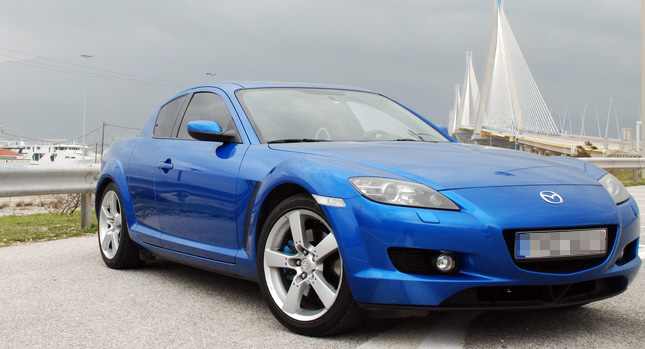

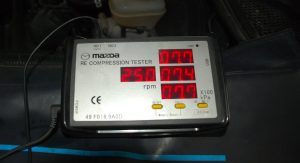
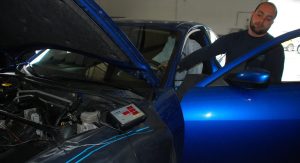
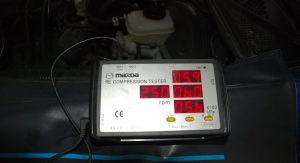
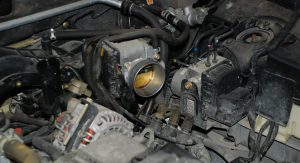
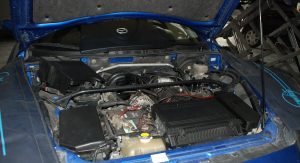
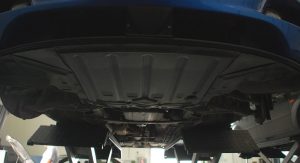
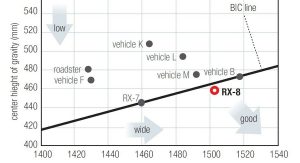
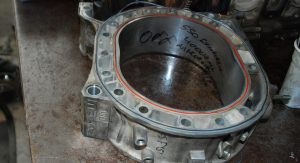

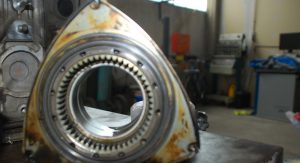
![RX-8-SERVICE-2[6] RX-8-SERVICE-2[6]](https://www.carscoops.com/wp-content/uploads/2013/04/b782a4a2-rx-8-service-225255b625255d25255b325255d-300x163.jpg)
